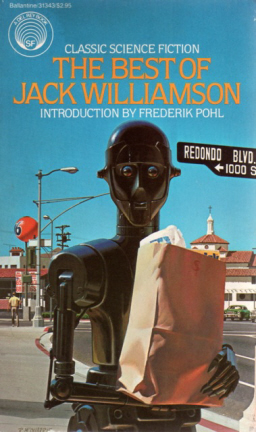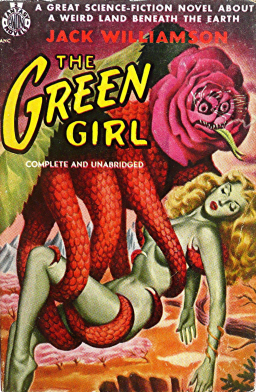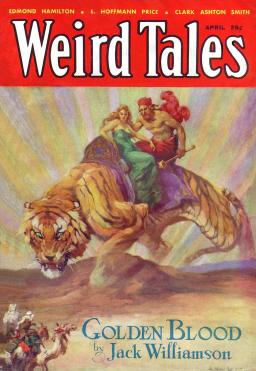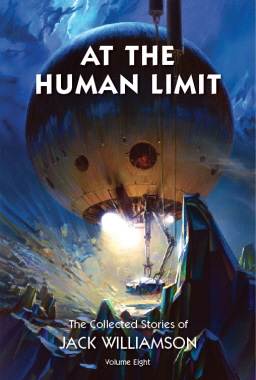Vintage Treasures: The Best of Jack Williamson
 Jack Williamson is a true legend among science fiction fans.
Jack Williamson is a true legend among science fiction fans.
My favorite story about Jack Williamson concerns his first published story, “The Metal Man,” published in the December 1928 issue of Amazing Stories, when he was just 20 years old. The editor, Hugo Gernsback, was notoriously slow in paying his authors… so slow, in fact, that Williamson discovered he had broken into the magazine when he first laid eyes on the issue in a magazine rack and recognized his hero on the cover.
Williamson was one of the earliest pulp writers and he had an impressive career right through the 30s. He survived the coming of Campbell and continued writing into the 40s, 50s, and much later.
Which brings me to my second favorite Jack Williamson story. In the late 90s, Williamson was still regularly publishing short stories in major magazines, including “The Firefly Tree” (Science Fiction Age, 1997), “The Hole in the World” (F&SF, 1997), and “Miss Million” (Amazing Stories, 1999). A buzz began to go around fandom that if Williamson appeared in the magazines in the year 2000, that would mean he had been published in professional SF magazines for eight straight decades — a feat unequaled and very likely to remain unequaled for a long time.
Fandom held its breath. Jack Williamson turned 92 years old in the year 2000. And he published no less than three short stories that year: “Agents of the Moon” (Science Fiction Age), “Eden Star” (Star Colonies, edited by Martin H. Greenberg), and finally “The Ultimate Earth” (Analog).
“The Ultimate Earth” was nominated — and won — the Hugo Award for best novella of the year. It also won the Nebula.
As for Williamson, he kept publishing stories. Two in 2001, three in 2002, one in 2003, and an incredible seven in 2004 (including a collaboration with Edmond Hamilton – don’t ask how that happened).
 He kept right on writing stories, in fact, until it looked entirely plausible he might complete another decade.
He kept right on writing stories, in fact, until it looked entirely plausible he might complete another decade.
Alas, it was not to be. Jack Williamson died in 2006, at the age of 98. He published a total of 26 stories in the 21st century — no mean feat at any age.
Of course, there was much more to Williamson than just his longevity. Or his short stories, for that matter.
Williamson’s first solo novel was The Green Girl, originally published in two parts in Amazing Stories (March and April, 1930) and reprinted in 1950 as Avon Fantasy Novel #2.
The novel is remembered today chiefly for the eye-opening cover of the paperback edition, painted by prolific pulp artist Ray Johnson. The novel has never been reprinted since 1950, but that cover has spawned thousands of posters and t-shirts. (Click on the image at right for a bigger version).
Williamson first made his mark as a pulp writer with the novel Golden Blood, published in six installments in Weird Tales, beginning in April 1933. It was eventually collected in paperback by Lancer in 1964
But his real claim-to-fame came with his Legion of Space series, beginning with a six-part serial in Astounding Stories in 1934, eventually collected as The Legion of Space in 1947.
One of the first true space operas, The Legion of Space follows the exploits of a daring team of the Legion, 30th Century policemen, defending the solar system from alien tentacled jellyfish called the Medusae.
Williamson followed the success of that first series with The Cometeers, a four-part serial in Astounding in 1936, and then One Against the Legion, a three-part serial in Astounding in 1939. Both short novels were collected by Ace Books in 1950 in a single volume titled The Cometeers.
 All three novels were collected in 1980 as Three from the Legion; the final installment, The Queen of the Legion, set after the disbanding of the legion, appeared in 1983.
All three novels were collected in 1980 as Three from the Legion; the final installment, The Queen of the Legion, set after the disbanding of the legion, appeared in 1983.
Williamson’s other novels include Realm of Wizardry (1940), Darker Than You Think (1948), Star Bridge (1955, with James E. Gunn), The Dome Around America (1955), The Reign of Wizardry (1964), Bright New Universe (1967), Brother to Demons, Brother to Gods (1979), Manseed (1982), Lifeburst (1984), Demon Moon (1994), The Silicon Dagger (1999), and Terraforming Earth (2001).
Jack Williamson’s last novel, and one of his last publications of any kind, was The Stonehenge Gate, published by Tor in 2005.
Williamson had a long and successful partnership with author and editor Frederick Pohl (who has his own entry in the Classic of Science Fiction series, and whom we’ll get to, fret not). It began in 1954 with Undersea Quest, followed by Undersea Fleet (1956) and Undersea City (1958).
Altogether, the two wrote more than a dozen science fiction novels together, in a partnership that lasted well into the 1990s, including Land’s End (1988), The Singers of Time (1991), the four-volume Starchild series, and five Cuckoo novels.
In the last few years, Jack Williamson’s early work has been gradually collected in sturdy permanent editions by the tireless Stephen Haffer, whose name has come up once or twice before in these articles. The Collected Stories of Jack Williamson has so far run eight volumes; the most recent, At The Human Limit, was released in April 2011.
The Best of Jack Williamson appeared in paperback in 1978. It was the 15th volume in Del Rey’s Classics of Science Fiction series, which was still going strong in 1978 (proudly announcing upcoming volumes covering Raymond Z. Gallun, Hal Clement, Lester Del Rey, and James Blish in the opening pages).
Fittingly enough, the introduction was by Frederick Pohl. The evocative cover — one of the best of the entire series — was by the brilliant Ralph McQuarrie, the concept artist for Star Wars.
The Starsweeping Sagas of Jack Williamson
“Nonstop to Mars”
A battered, old airplane made its bizarre last flight… and made a most successful landing on another planet!“With Folded Hands”
The robots met every human need and left mankind with nothing whatever to do.“The Happiest Creature”
He had a woman to brutalize and an enemy to kill… what more could anyone want?“Jamboree”
That was the high spot of the year… at least for those who came back from the celebration!“The Highest Dive”
The freak winds of the impossible planet snatched him 100 miles into the air… and then the adventure really began!The questing mind and storytelling power of Jack Williamson have given science fiction some of its most memorable writing from its very beginning — and these 14 stories show this Grand Master of science fiction at his provocative and Protean best.
There was no science fiction book club edition of The Best of Jack Williamson (although the Legion omnibus Three from the Legion was published by the SFBC at around the same time).
Here’s the complete table of contents:
Table of Contents
“Jack Williamson: The Pathfinder” by Frederik Pohl
“The Metal Man” (Amazing Stories, Dec 1928)
“Dead Star Station” (Astounding Stories, Nov 1933)
“Nonstop to Mars” (Argosy, Feb 1939)
“The Crucible of Power” (Astounding Stories, Feb 1939)
“Breakdown” (Astounding Science Fiction, Jan 1942)
“With Folded Hands” (Astounding Science Fiction, July 1947)
“The Equalizer” (Astounding Science Fiction, March 1947)
“The Peddler’s Nose” (Astounding Science Fiction, April 1951)
“The Happiest Creature” (Star Science Fiction Stories No. 2, 1953)
“The Cold Green Eye” (Fantastic, March-April 1953)
“Operation: Gravity” (Science Fiction Plus, Oct 1953)
“Guinevere for Everybody” (Star Science Fiction Stories No. 3, 1954)
“Jamboree” (Galaxy, Dec 1969)
“The Highest Dive” (Science Fiction Monthly, Volume 3, No. 1, 1976)
Afterword, by Jack Williamson
The Best of Jack Williamson was published in June 1978 by Del Rey Books. It is 386 pages in paperback, originally priced at $1.95. It is out of print. There is no digital edition.
The last volume in the Classic Library of Science Fiction we examined was The Best of Fritz Leiber. So far we’ve covered (in order of publication):
The Best of Stanley G. Weinbaum
The Best of Fritz Leiber
The Best of Henry Kuttner
The Best of John W. Campbell
The Best of C M Kornbluth
The Best of Philip K. Dick
The Best of Fredric Brown
The Best of Edmond Hamilton
The Best of Murray Leinster
The Best of Robert Bloch
The Best of Jack Williamson
The Best of Hal Clement
The Best of James Blish
The Best of John Brunner
See all of our recent Vintage Treasures here.

I just read the Legion of Space stories a few months ago and quite enjoyed them, particularly the first two novels, which have utterly huge ideas and great swashbuckling action.
Darker Than You Think should be more well-known than it is. Arguably Williamson’s best book?
I love the story that Williamson’s life goes so far back that when his parents moved to New Mexico, they did so in a covered wagon. The man predated airplanes but lived to see men walk on the moon and the proliferation of cell phones.
Andy,
Indeed. Most of us understand the impact of technology on multiple generations as an abstract concept, like evolution; Jack Williamson lived it. In many ways, he embodied science fiction like no other 20th Century SF writer.
[…] here on the blog; just in the last few weeks I commented on his successful collaborations with Jack Williamson and C. M. Kornbluth. Rich Horton, who has been examining vintage SF digests for us, recently […]
[…] last volume in the Classic Library of Science Fiction we examined was The Best of Jack Williamson. So far we’ve covered (in order of […]
[…] my previous piece, on The Best of Jack Williamson, I also observed that Williamson had ”survived the coming of Campbell,” by which I […]
[…] of Philip K. Dick The Best of Edmond Hamilton The Best of Murray Leinster The Best of Robert Bloch The Best of Jack Williamson The Best of Hal […]
[…] of Philip K. Dick The Best of Edmond Hamilton The Best of Murray Leinster The Best of Robert Bloch The Best of Jack Williamson The Best of Hal […]
[…] of Philip K. Dick The Best of Edmond Hamilton The Best of Murray Leinster The Best of Robert Bloch The Best of Jack Williamson The Best of Hal […]
[…] has nothing to do with D&D. Could have told you that. Guys, guys. You should have read our Jack Williamson feature last month. This is why we do this […]
[…] of Philip K. Dick The Best of Edmond Hamilton The Best of Murray Leinster The Best of Robert Bloch The Best of Jack Williamson The Best of Hal […]
[…] of Fredric Brown The Best of Edmond Hamilton The Best of Murray Leinster The Best of Robert Bloch The Best of Jack Williamson The Best of Hal Clement The Best of James […]
[…] of Fredric Brown The Best of Edmond Hamilton The Best of Murray Leinster The Best of Robert Bloch The Best of Jack Williamson The Best of Hal Clement The Best of James […]
[…] few months ago I wrote about The Best of Jack Williamson, a fun refresher course for me in one of the great science fiction writers of the pulp era. It also […]
[…] he wrote for over six decades. That’s two decades shy of Jack Williamson’s astonishing eight-decade run as an SF writer, but still pretty darned impressive. He made his fiction debut in the Summer 1945 […]